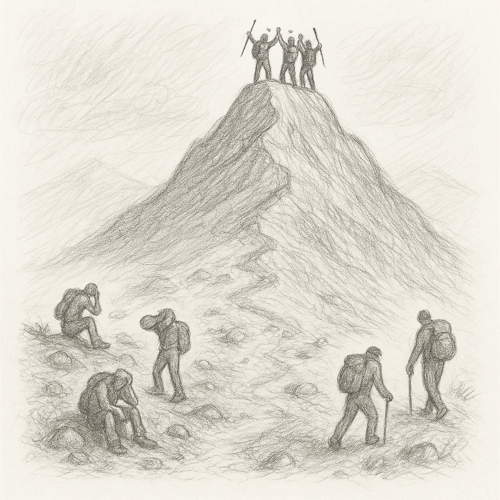Two Teams & a Mountain
Illustrates Alignment, Different Perspectives, Collaboration
In the world of Agile, teams are often tasked with reaching ambitious goals under uncertain conditions. The question is not simply whether they move quickly, but whether they move wisely, together, and with the ability to adapt. Stories can help us explore these ideas more deeply by tapping into metaphor and experience.
The parable of Two Teams and a Mountain illustrates the contrast between two approaches to problem-solving and teamwork: one driven by speed and assumptions, and another guided by shared purpose, adaptability, and learning. It is not a story about climbing in the literal sense, but about navigating complexity in product development, organizational change, and everyday Agile work.

Two teams stood at the base of a great mountain. Each was tasked with reaching the summit.
The first team agreed quickly: take the direct path and move fast. They charged forward confidently. But as the terrain became more unpredictable, they were caught off guard. Fog rolled in. The path turned steep and treacherous. Team members disagreed on which direction to go. Some pushed ahead blindly. Others turned back. Progress came to a halt.
The second team took a different approach. They defined shared goals and agreed to pause regularly to inspect and adapt. They traveled light and kept each other informed. When they hit obstacles, they worked through them together. They did not rush, but they did not stop either. Slowly and steadily, they made their way up the mountain together.
Lessons Learned
Direction Is More Important Than Speed
A fast start can feel productive, but without shared direction and goals, speed leads to waste and rework. Agile teams thrive when they take time to align around a clear purpose and regularly check that they are still on the right path.
Adaptability Beats Rigidity
The first team's rigid commitment to a single plan made them brittle when conditions changed. In contrast, the second team's willingness to adjust allowed them to stay in motion even when the terrain shifted. Agile teams succeed by embracing change and refining their plans with each step forward.
Psychological Safety Fuels Progress
The ability to pause, speak openly, and support one another was a key difference for the second team. Teams that feel safe sharing concerns, asking questions, and suggesting changes are far more likely to spot risks early and improve continuously.
Simplicity And Focus Reduce Friction
Carrying only what was needed allowed the second team to move with clarity and efficiency. Agile teams benefit from the same principle: limit work in progress, reduce handoffs, and focus on finishing what matters most. This creates space to respond when surprises occur.
Shared Learning Strengthens The Whole Team
The second team improved through regular reflection, not just individual expertise. Agile practices like Retrospectives, spikes, and knowledge sharing help the team grow as a unit. Learning is not a luxury, it's a survival skill.
Progress Is Not Always Linear
The winding path may seem slower, but it allows for discovery, course correction, and sustainability. Agile work often involves setbacks, experimentation, and shifts in understanding. Forward momentum is built through deliberate, informed steps rather than constant acceleration.
Support Systems Matter
The second team succeeded not just because of their mindset, but because they had mechanisms to pause, reassess, and support one another. Agile teams need clear working agreements, time for reflection, and a culture that values both progress and people.
Coaching Tips
- Model the Mountain: Use this parable in retrospectives. Ask the team which group they relate to and why.
- Highlight Reflection Rituals: Emphasize the value of Retrospectives, Daily Scrums, and feedback loops as intentional pause points in the journey.
- Check the Load: Are team members overloaded? Encourage conversations about work in progress, multitasking, and what is truly necessary.
- Use the Terrain Metaphor: In planning meetings, ask what kind of terrain lies ahead. This helps gauge complexity and adjust the process.
- Build Summit Stories: Invite teams to describe what success looks like. What is their summit? Who needs to reach it with them?
Agile is not just a set of ceremonies or events. It is a way of thinking about progress in uncertain and shifting environments. The mountain represents any product, feature, transformation, or goal your team is pursuing. Some climbs appear simple at first but become complex. Others are challenging from the beginning.
The real question is not, “Are we moving?” It is, “Are we moving together and learning as we go?”


